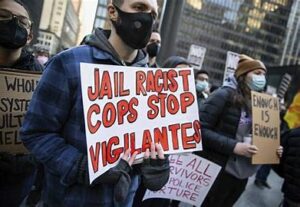Title: Vigilantism and Citizen Justice in the USA: Examining Causes, Impacts, and Legal Responses
Abstract:
Vigilantism and citizen justice, the act of individuals taking the law into their own hands outside of legal frameworks, have a long and complex history in the United States. This essay provides a comprehensive analysis of vigilantism and citizen justice in the USA, exploring their historical roots, contemporary manifestations, underlying causes, societal impacts, and legal responses. By examining case studies, cultural representations, and scholarly research, this essay sheds light on the motivations behind vigilantism, its implications for social order and justice, and the challenges it poses to the rule of law. Furthermore, it discusses the ethical dilemmas and complexities associated with citizen justice, and advocates for legal, institutional, and social measures to address underlying grievances and prevent extrajudicial violence.
Keywords: Vigilantism, Citizen Justice, Extrajudicial Violence, Rule of Law, USA
-
Introduction
Vigilantism and citizen justice, defined as the enforcement of perceived justice by individuals or groups outside of legal authority, have a profound and contentious history in the United States. From the frontier justice of the Wild West to contemporary acts of vigilantism spurred by social media outrage, citizen justice reflects complex dynamics of power, morality, and social order.

This essay provides a comprehensive analysis of vigilantism and citizen justice in the USA, examining their historical roots, contemporary manifestations, underlying causes, societal impacts, and legal responses. By exploring case studies, cultural representations, and scholarly research, this essay aims to deepen understanding of vigilantism, its consequences for justice and social cohesion, and the challenges it poses to the rule of law.
-
Historical Roots of Vigilantism
Frontier Justice:
The notion of vigilante justice has deep roots in American history, particularly during the frontier era of the 19th century. In the absence of formal law enforcement institutions, settlers often formed vigilante committees to maintain order, enforce community norms, and address perceived threats to safety and property.
Lynch Law:
The term “lynch law” originated from the extrajudicial punishment meted out by mobs or vigilante groups, particularly against African Americans during the Reconstruction era and Jim Crow era. Lynchings were often carried out as acts of racial terror, intimidation, and social control, reflecting deep-seated prejudices and systemic injustices.
Civil Rights Era:
Vigilantism persisted during the Civil Rights Movement, with white supremacist groups such as the Ku Klux Klan engaging in acts of violence and terror against African American activists, civil rights leaders, and communities. These acts of vigilantism were aimed at maintaining white supremacy and resisting social change.
-
Contemporary Manifestations of Vigilantism
Neighborhood Watch Programs:
Neighborhood watch programs, intended to enhance community safety and crime prevention, have sometimes been criticized for fostering vigilantism and racial profiling. Instances of vigilantism by neighborhood watch volunteers, such as the Trayvon Martin case, have sparked debates about racial bias and vigilantism.
Online Vigilantism:
The rise of social media and digital communication platforms has facilitated new forms of vigilantism, with individuals using online platforms to expose alleged wrongdoers, shame offenders, and seek retribution. Online vigilantism raises concerns about privacy, due process, and the potential for online harassment and mob justice.

Militia Movements:
Militia groups, often characterized by anti-government sentiments and paramilitary ideologies, represent a form of vigilantism outside of legal authority. While some militia groups claim to uphold constitutional rights and protect communities, others engage in extremist ideologies, violence, and domestic terrorism.
-
Causes of Vigilantism
Perceived Injustice:
Vigilantism often arises from a sense of frustration or disillusionment with formal legal institutions perceived as ineffective, corrupt, or biased. Individuals may resort to vigilantism when they feel that traditional avenues of justice have failed to address their grievances or protect their communities.
Moral Outrage:
Acts of vigilantism are sometimes motivated by moral outrage over perceived injustices, such as cases of child abuse, animal cruelty, or public corruption. Vigilantes may believe that they are acting in the best interests of society by meting out swift and decisive justice to offenders.
Social Disintegration:
Vigilantism can be symptomatic of broader social disintegration, characterized by erosion of social cohesion, breakdown of community bonds, and loss of trust in institutions. In contexts of social instability or economic hardship, individuals may turn to vigilantism as a means of asserting control and restoring order in their communities.
-
Impacts of Vigilantism
Erosion of Rule of Law:
Vigilantism undermines the rule of law by circumventing legal processes, undermining due process rights, and substituting mob justice for impartial adjudication. Extrajudicial violence erodes public trust in legal institutions and perpetuates cycles of violence and retaliation.
Social Polarization:
Vigilantism can exacerbate social divisions and polarizations by reinforcing stereotypes, fueling resentment, and exacerbating conflicts between different groups. Acts of vigilantism based on race, religion, or ideology can deepen societal fissures and undermine efforts to promote inclusivity and tolerance.
Vigilante Violence:
Vigilantism carries the risk of vigilante violence, with individuals taking the law into their own hands and resorting to acts of aggression, intimidation, or retribution against perceived wrongdoers. Vigilante violence can escalate tensions, provoke counter-violence, and result in harm to innocent individuals.

Impunity and Injustice:
Vigilantism often leads to impunity for perpetrators and miscarriages of justice for victims, as extrajudicial actions bypass legal safeguards and accountability mechanisms. Victims of vigilantism may be denied their rights to fair trial, legal representation, and protection from arbitrary punishment.
-
Legal Responses to Vigilantism
Criminalization:
Vigilantism is generally illegal under state and federal laws, which prohibit individuals from taking the law into their own hands and engaging in acts of violence or coercion. Criminal statutes may impose penalties for vigilantism, including assault, battery, false imprisonment, and civil rights violations.
Law Enforcement Intervention:
Law enforcement agencies have a responsibility to investigate and prosecute acts of vigilantism, uphold the rule of law, and protect individuals from extrajudicial violence. Police departments may collaborate with community organizations, civil rights groups, and legal advocates to address vigilantism and promote community safety.
Community Engagement:
Community-based approaches to crime prevention and conflict resolution can help address underlying grievances and reduce the risk of vigilantism. Community policing initiatives, restorative justice programs, and conflict mediation services empower communities to resolve disputes peacefully and strengthen social cohesion.
Education and Awareness:
Public education campaigns and awareness-raising initiatives can help dispel myths about vigilantism, raise awareness of legal rights and responsibilities, and promote alternatives to extrajudicial violence. Educating individuals about the dangers of vigilantism and the importance of respecting legal processes can foster a culture of accountability and respect for the rule of law.
-
Ethical Dilemmas and Complexities
Moral Justifications:
Vigilantes may justify their actions based on moral principles, such as protecting vulnerable individuals, defending community values, or seeking retribution for perceived wrongs. However, moral justifications for vigilantism can be subjective, arbitrary, and incompatible with principles of justice and due process.

Accountability and Oversight:
Vigilantism raises questions about accountability, oversight, and legitimacy, as extrajudicial actions lack legal authorization, procedural safeguards, and checks and balances. Without mechanisms for accountability and oversight, vigilantes may act with impunity and disregard legal norms.
Risks of Escalation:
Vigilantism carries the risk of escalation, as acts of vigilantism can provoke retaliation, counter-violence, and cycles of vendetta and reprisal. Without lawful mechanisms for resolving disputes and addressing grievances, vigilante conflicts can spiral out of control and result in widespread harm and social disorder.
Psychological Impacts:
Engaging in vigilantism can have profound psychological impacts on individuals, including feelings of guilt, remorse, and trauma. Perpetrators of vigilantism may experience moral distress, cognitive dissonance, and psychological trauma as a result of their actions, highlighting the human toll of extrajudicial violence.
-
Conclusion
Vigilantism and citizen justice pose significant challenges to the rule of law, social order, and democratic governance in the United States. While motivated by a desire for justice, vigilante actions undermine legal processes, exacerbate social divisions, and perpetuate cycles of violence and retaliation. Addressing vigilantism requires a multifaceted approach that combines legal measures, community engagement, and public education to address underlying grievances, promote accountability, and strengthen respect for the rule of law. By addressing the root causes of vigilantism and fostering a culture of legality and civility, society can work towards a more just, equitable, and peaceful future.



